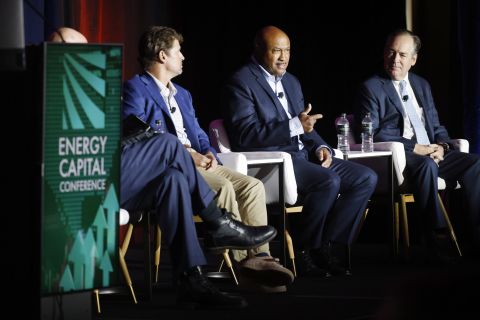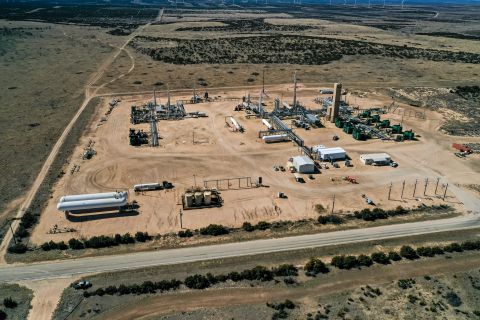A small area in far western Virginia is pushing out amazing volumes of natural gas. The state's production has jumped forcefully in recent years, from 2.8 billion cubic feet (Bcf) in 1970 to more than 85 Bcf in 2004. About three-fourths of this gas flows from coalbed-methane (CBM) wells. According to the Virginia Division of Oil and Gas, as of the end of 2004, more than 2,500 CBM wells had been drilled. At press time, seven rigs were working in the Old Dominion State, four in Buchanan and three in Dickenson County. While coal seams occur throughout the central Appalachian Basin, this particular corner of the province offers thick seams at attractive depths of 1,000 to 2,500 feet, reports Coalbed Natural Gas Report. Gas content in the bituminous coals ranges up to 600 standard cubic feet per ton, and numerous thin coal seams are layered through the section. Most of the CBM is produced from the Pocahontas seams. Fort Worth, Texas-based Range Resources Corp. picked up a major interest in the play in late 2004 when it purchased 1,872 wells and acreage from a private party. A large chunk of the asset was centered in Nora Field, in Dickenson County, Virginia. Range gained net daily production of 14.8 million cubic feet of gas, 70% from CBM wells at depths from 1,200 to 2,500 feet. The remaining slice was from tight-gas wells drilled into sandstone reservoirs below the coals, at depths from 4,500 to 5,500 feet. "People don't think of Virginia as an oil and gas producing state, but finding costs are very attractive and the upside is huge," says Jeff Ventura, Range chief operating officer and executive vice president. "There's tremendous production left to be had in this area." During 2005, its first year of operation in the play, Range drilled 159 wells in Nora Field and 16 wells in adjacent Haysi Field. This year, it plans 200 wells in Nora and 35 wells in Haysi. The company holds interests in 287,000 acres, with working interests and minerals under most of its lands. The typical Nora Field CBM well encounters 23 feet of completable coal, and recovers between 350- and 400 million cubic feet of gas. Very little water is produced from these seams, and after a short dewatering phase, the wells produce at rates of 70,000 to 100,000 cubic feet per day for four to five years before beginning a gradual decline. "The dewatering phase only lasts about six months," says Ventura. At present, Range enjoys net production of 21 million cubic feet per day from Nora Field, from both CBM and tight-sand reservoirs. That's about 30% above the estimates it used for its acquisition economics. Furthermore, the company projects production growth of 15% per year for each of the next seven years in the play. And Range has the locations to back that up: its current count is 624 proven CBM locations, and more than 2,100 unproven locations, on 60-acre spacing. Less than 15% of the CBM reserves on its properties have been developed. "The economics of these shallow wells are very stout," says Ventura. The wells are 2,500 feet deep and cost about $300,000 each to drill and complete. "Our finding costs are well under a dollar, and rates of return are excellent." Indeed, at natural gas prices of $6 per thousand cubic feet, rates of return are 43%. That rises to 83% at $9 gas. In regard to its drilling locations, the company has 98 billion cubic feet equivalent of proven and more than 450 billion equivalent of unproven reserves. "Our success rate is 100%. It's very exciting. This play stacks up well against any other." Additional pluses for Virginia CBM are the premium prices gas fetches in the Appalachian Basin and the relative ease of obtaining permits, particularly as compared with federal lands in the western U.S. Another Virginia operator is newly public CNX Gas Corp., a subsidiary of Consol Energy. South Park, Pennsylvania-based CNX produces about 140 million cubic feet per day from its properties in Nora and Oakwood fields. This year, the firm expects to drill 215 vertical wells and three horizontal wells. Additionally, it will drill a number of gob wells in Virginia, says Dan Zajdel, director of investor relations. (For more on Virginia CBM, see the January 2005 issue.)
Recommended Reading
Post Oak Backs New Permian Team, But PE Faces Uphill Fundraising Battle
2024-10-11 - As private equity begins the process of recycling inventory, likely to be divested from large-scale mergers, executives acknowledged that raising funds has become increasingly difficult.
Analyst: Is Jerry Jones Making a Run to Take Comstock Private?
2024-09-20 - After buying more than 13.4 million Comstock shares in August, analysts wonder if Dallas Cowboys owner Jerry Jones might split the tackles and run downhill toward a go-private buyout of the Haynesville Shale gas producer.
BP Profit Falls On Weak Oil Prices, May Slow Share Buybacks
2024-10-30 - Despite a drop in profit due to weak oil prices, BP reported strong results from its U.S. shale segment and new momentum in the Gulf of Mexico.
Oxy’s Hollub Drills Down on CrownRock Deal, More M&A, Net-zero Oil
2024-11-01 - Vicki Hollub is leading Occidental Petroleum through the M&A wave while pioneering oil and gas in EOR and DAC towards the goal of net-zero oil.
Midstream M&A Adjusts After E&Ps’ Rampant Permian Consolidation
2024-10-18 - Scott Brown, CEO of the Midland Basin’s Canes Midstream, said he believes the Permian Basin still has plenty of runway for growth and development.
Comments
Add new comment
This conversation is moderated according to Hart Energy community rules. Please read the rules before joining the discussion. If you’re experiencing any technical problems, please contact our customer care team.





